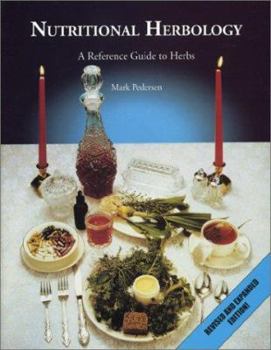Nutritional Herbology: A Reference Guide to Herbs
Select Format
Select Condition 
Book Overview
Have you ever wondered which herbs are good sources of Iron, Chromium, Selenium or Calcium? Well, this book is for you. Mark Pedersen's Nutritional Herbology is a one-of-a-kind resource book giving... This description may be from another edition of this product.
Format:Paperback
Language:English
ISBN:1885653077
ISBN13:9781885653079
Release Date:May 1998
Publisher:Whitman Pubns
Length:336 Pages
Weight:2.17 lbs.
Dimensions:11.3" x 1.0" x 8.8"
Customer Reviews
5 ratings
Priceless Book
Published by Thriftbooks.com User , 14 years ago
Best herb reference and nutrient content book on the market. Awesome stats and reference materials.
Nutritonal Herbology: A referance guide to Herbs
Published by Thriftbooks.com User , 14 years ago
The book is very informative an exelent work, a must read referance guide I love it.
Ancient knowledge in one book
Published by Thriftbooks.com User , 16 years ago
This book is a must for anyone interested in health and nutrition. It was recommended to me by a friend who is very knowledgable in herbology. It is a good guide in the relationships of different herbs also.
Nutritional Herbology book review
Published by Thriftbooks.com User , 17 years ago
new book, excellent condition--very informative, just what I was looking for--recommend reading to greatly expand herbal/medical knowledge--I am an herbalist and a nurse, so I know what I'm talking about! M.L. Watts
One of few books to list nutrients and minerals in herbs.
Published by Thriftbooks.com User , 25 years ago
This book is one of very few that list the nutrients found in common western and Chinese herbs, allowing one to find which herbs are good sources of, say selenium or beta carotene. As such it is an important addition to any herbalist's library. However like most food science analyses, the book lists nutrients found in the plant, not nutrients which can or will be absorbed by the human body. For example, aluminium intake is closely regulated by the gut flora and excess aluminum is normally excreted unless that flora has been decimated by antibiotics or unhealthy diets. Its presence in an herb does not automatically mean that an herb like echinacea, which rates moderately high in aluminum, should be avoided.The actions of herbs often go far beyond their constituents. Yellow dock, for example is not especially high in iron, yet yellow dock tincture (which contains very little iron at all) can in low doses allow the body to overcome anemia far faster than iron supplements.However with those caveats, the book is highly recommended. It also lists actions of herbs, the body systems affected, folk history and use of the plants, medicinal properties, chemical constituents, nutrients of note and typical dialy doses in various forms. Of particular note are traditional combination formulas which are analyzed like the single herbs for their nutritional profiles.A worthwhile reference for those seriously interested in herbal medicine and nutrition.






